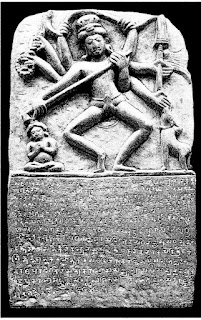இந்தியாவின் பழமையான நடராஜர் திருமேனி ஒடிசாவின் அசன்பத் பொஆ 300 நடராஜர் திருமேனிகீழே 13 வரி சமஸ்கிருத கல்வெட்டு
நடராஜர் திருமேனிகீழே 13 வரி சமஸ்கிருத கல்வெட்டும் பொஆ 300 சார்ந்த ஒடிசாவில்நாகர் அரசன் சத்ருபஞ்சா புகழைக் கூறும் (Satrubhanja பொஆ 261 முதல் 340 வரை)
ஒடிசாவின் அசன்பத் கிராமத்தில் கிடைத்துள்ள சத்ருபஞ்சாவின் பதின்மூன்று வரி சமஸ்கிருதக் கல்வெட்டு . https://en.wikipedia.org/wiki/Satrubhanja
அசன்பத் கிராமத்தில் கிடைத்துள்ள நடராசரின் கல்வெட்டு சமசுகிருத மொழியில், பிந்தைய பிராமி அல்லது சத்ருபஞ்சாவின் ஆரம்பகால கலிங்க எழுத்துகளுடன், வெற்றியாளர் எனவும் ஆன்மீக மனிதராக இவர் செய்த சாதனைகள் பற்றியும் விரிவான விவரங்களை வழங்குகிறது. பதின்மூன்று வரிகளைக் கொண்ட கல்வெட்டு பகுதி வசனமாகவும், பகுதி உரைநடையாகவும் எழுதப்பட்டுள்ளது.
இப்போது ஒடிசா மாநில அருங்காட்சியகத்தில் வைக்கப்பட்டுள்ள அசன்பத் கல்வெட்டு, சத்ருபஞ்சாவை ஆட்சியாளர் எனவும் போர்வீரன் எனவும் விரிவான கண்ணோட்டத்தை அளிக்கிறது. இவர் நாக குலத்தில் அரசர்களிடையே சந்திரனைப் போலப் பிறந்தவர் என்றும், மகாபாரதத்தில் பீஷ்மருக்கு வழங்கப்பட்ட சிறப்புப் பெயரான இரனஸ்லாகின் (போரில் பெருமை கொண்டவர்) என்றும் விவரிக்கப்படுகிறார்.
ஒடிஷா மாநிலத்தின் அருங்காட்சியத்தில் மஹாராஜா சத்ருபாஞ்சாவின் கல்வெட்டு ஒன்று காட்சிப்படுத்தப்பட்டுள்ளது. இந்த கற்பலகையின் மேற்பகுதியில் ஆடல்வல்லானின் சிற்பம் ஒன்று நேர்த்தியாக வடிக்கப்பட்டுள்ளது. இதனில் சிவபெருமான் ஆடும் தோற்றத்தில் நிமிர்க்குறி தெளிவுற அமைக்கப்பட்டு எட்டுக்கரங்களுடன் முன்னிரு கரங்களில் வீணை போன்ற இசைக்கருவியை மீட்டும் பாவனையில் வடிக்கப்பட்டுள்ளார்.
தலைக்கு மேலே உயர்த்திய இருகரங்கள் ஒரு நாகத்தினை பிடித்துள்ளன. இடது கரமொன்றில் முத்தலை சூலம் ஏந்தி மற்றொரு கரமோ இடபத்தை வருடியவண்ணம் காண்பிக்கப்பட்டுள்ளார். வலப்பக்கம் இரு கைகளில் ஒன்றில் டமருகமும் மற்றொன்றில் அக்கமாலையும் பிடித்துள்ளார். இவரது மெலிந்த தேகத்தில் முப்புரிநூல் தெளிவாக விளங்க சதுர தாண்டவ அமைப்பில் கால்கள் நடனமிட ஒரு பூதகணம் அவரை வணங்கும் பாவனையில் அவருக்கு வலப்புறத்தே அமர்ந்துள்ளது நோக்கத்தக்கது.
சிரசின் மீது கொண்டை போல இறுக்கிக்கட்டிய ஜடாமகுடமும் அங்கு இலங்கும் பிறைச்சந்திரனும் அழகாக அதன் மேல் ஒரு ருத்ராஷ மாலையும் இவரது மேனிக்கு மேலும் அழகு சேர்க்கின்றது.
இந்த சிற்பம் அசன்பேட் கல்வெட்டு என்று வெகு பிரபல்யமாக தொல்துறையினைச் சார்ந்தோரால் பிரஸ்தாபிக்கப்படுகிறது. பொ.யு.ஆறாம் நூற்றண்டை சேர்ந்த இந்த கல்வெட்டின் கிரந்தம் குப்தர்கள் கால பிராமியில் நாகர் அரச மரபினை சேர்ந்த சத்ருபாஞ்சதேவன் என்னும் அரசனின் கீர்த்தியையும் அவன் ஒரு சிவன் கோயில் எழுப்பியதைப்பற்றியும் பல மடங்களுக்கு பொற்காசுகள் வழங்கியதைப்பற்றியும் அவனது விழுமிய சைவத்தொண்டினையும் பலகோட்பாடுகளிலும் தத்வார்த்தங்களிலும் சாஸ்திரங்களிலும் தேர்ச்சிபெற்ற வல்லமையையும் கவிதையாகவும் உரைநடையிலும் விவரிக்கின்றது. சுமார் நான்காம் நூற்றாண்டு காலங்களில் இவன் க்யூஞ்சார் பகுதியில் ஆட்சி புரிந்தவன்.
Ravichandran KP The Asanpat inscription and dancing Shiva of Sixth Century exhibited in Odisha State Museum.
The Asanpat inscription which is now kept in the Odisha state museum gives a detailed overview of Satrubhanja's life as ruler and warrior. He is described as born like moon among kings in the Naga clan and as the distinguished Ranaslaghin (warrior). He is also described as a divine child born to a family the fame of which would last till the end of the Kali yuga. Probably he belonged to a very high class Naga clan family and according to the inscription was expected to win battles with the enemies in the future. Satrubhanja is described as the ruler of Vindhyatabi (Keonjhar and adjoining modern Mayurbhanj - Singhbhum districts). He was the son of Maharaja Manabhanja and the queen Mahadevi Damayanti. He was a successful warrior who is defined by the statement that his heroism remains unchallenged even after hundreds of battles with the Murundas and Kushans. He is described as the Kalpavriksha who possessed the quality of good wealth on earth similar to the sun having mass splendor on earth.
The inscription describes Satrubhanja’s knowledge in the Puranas and Mahabharata. He is mentioned to have mastered the knowledge of Itihasa, Vyakarana, Samiksa, Nyaya, Mimamsa, Chandas, Vedas, Buddhist Scriptures and Samkhya and also described as the expert in all arts. Satrubhanja had built monasteries and residences for spiritual men from different religious communities in his empire. The religious communities patronized by him included Brahmacharis, Parivrajakas or Jains, Bhikshus and Nirgranthakas of Buddhist religion. Towards the end of the inscription it also notes down that he had built a large temple for the Hindu deity, Shiva.[5] Broken burnt bricks and rubble of an ancient structure are found in the Asanpat area believed by many scholars to be the remnants of this temple.
.jpg)


No comments:
Post a Comment